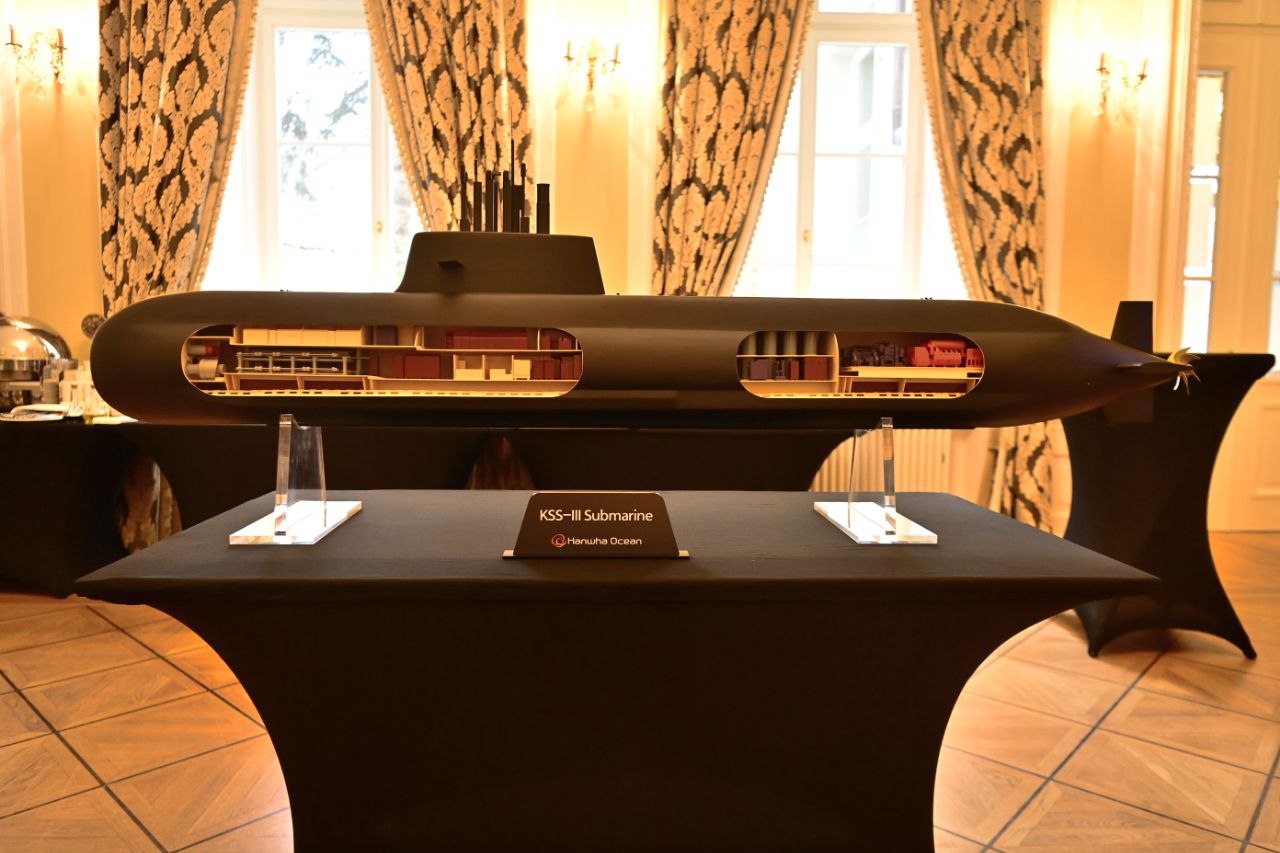November 29, 2023 – Hanwha Ocean, a maritime sector entity within the Hanwha Business Group in South Korea, has expressed its aspirations for a strategic collaboration with Poland in the naval sector.
During a press conference at Hotel Belloto in Warsaw, Hanwha Ocean unveiled a comprehensive package of proposals. The company aims to present to the Polish Navy its cutting-edge and sea-proven KSS-III Submarine, contributing to enhanced security in the Baltic Sea. Additionally, Hanwha Ocean shared its vision for Poland by establishing a strong industrial partnership, bringing economic and industrial benefits to the country.
Vice President Sung Kyun Jeong, Head of Hanwha Ocean’s Naval Ship International Business, said: “We are ready to offer the KSS-III Submarine, one of the world’s best submarines, for Poland’s Orka Project. We also want to share our long-term vision for the partnership with Poland on this occasion.”

Currently in active service with the Republic of Korea (ROK) Navy, the 3,600-ton class KSS- III has demonstrated advanced technologies and capabilities, contributing to enhanced deterrence of Poland.
Hanwha Ocean envisions not only providing state-of-the-art submarines but also offering comprehensive training programs for the Polish Navy. Collaborating with the Korean Navy, the training will encompass basic submarine courses, equipment operation training, tactical training with simulators, and onboard training at sea. Hanwha Ocean also mentioned that the Korean Navy is willing to support sea trials and on-the-job training, as well as share its submarine operation and maintenance know-how with the Polish Navy.
In a move to bolster Poland’s self-sufficiency in maintaining its submarine fleet, Hanwha Ocean plans to establish a Maintenance, Repair, and Overhaul (MRO) Center in Poland. This center will not only provide technical support through an on-site team but also ensure the timely delivery of spare parts, manage obsolescence, and offer extensive MRO knowledge, empowering Poland to independently sustain its submarine fleet efficiently.

Expanding beyond the military scope, Hanwha Ocean’s proposal aims to foster a strategic pathway for Poland’s industry. The collaboration goes beyond naval projects, encompassing partnerships in commercial vessels and offshore projects, showcasing Hanwha Ocean’s expertise in these domains. The company also expresses a keen interest in exploring opportunities in renewable energy and engaging in research and development with Polish institutes and universities.
Highlighting the comprehensive nature of the collaboration, Hanwha Ocean envisions a contribution to the growth and prosperity of both nations. The proposal is designed to stimulate local prominent small and medium-sized enterprises, create jobs, and cooperate in reciprocal technology development. By offering a holistic approach to industrial cooperation, Hanwha Ocean aims to position itself as a long-term partner, fostering enduring ties between South Korea and Poland.
About Hanwha Ocean
Hanwha Ocean, established in 1973, has evolved over the past half-century to become a global industry leader in shipbuilding and offshore engineering.
Located in the Geoje Island in South Korea’s Gyeongsangnam-do region, the company’s shipyard has been instrumental in its journey towards becoming a worldclass shipbuilder. With a relentless focus on advanced technology and innovation, Hanwha Ocean has consistently paved the way for new business ventures, demonstrating its ability to construct a diverse range of vessels, including commercial ships, offshore platforms, and naval ships like submarines and destroyers.
With over 40 years of experience, Hanwha Ocean’s extensive portfolio stands out due to its rich history and expertise in submarine construction. Stemming from its involvement in the Korean Attack Submarine Program (KSS), Hanwha Ocean embarked on a journey that began with the construction of KSS-I submarines for the Korean Navy in 1983.
Subsequently, the company played pivotal roles in the KSS-II and KSS-III projects, along with numerous submarine overhaul and modernization endeavors. Notably, as the designated contractor for supplying the Korean Navy’s next-generation 3,600-ton KSS-III submarines, Hanwha Ocean has exhibited its capability to independently design and construct submarines of the highest standards.
About KSS-III
KSS-III, the Korea Navy’s most recent submarine, has length of about 90 meters, and a displacement of 3,600 tons.
At the heart of KSS-III’s technological excellence is its innovative propulsion system, which includes an advanced Lithium-ion battery and Air Independent Propulsion (AIP) system. This combination allows the submarine to redefine the possibilities of submerged operations, setting a new standard for conventional submarines. In fact, KSS-III stands out by achieving the world’s longest submerged operations period over three weeks, demonstrating its endurance and operational efficiency.
The submarine’s lethal firepower adds another layer to its capabilities, as it can launch a diverse array of weapons. From Submarine-Launched Ballistic Missiles (SLBMs) and Submarine-Launched Cruise Missiles (SLCMs) to anti-ship missiles, torpedoes, and mines, KSS-III ensures a formidable combat capability.
Beyond its combat capabilities, KSS-III has optimized hull designs that minimize noise emissions, providing a stealthy and agile presence underwater. Its advanced combat management systems and SONARs further contribute to its technological superiority, and its communication system ensures full interoperability with allied navies.
Since its deployment with the Republic of Korea Navy (ROKN) in 2021, KSS-III has demonstrated its real-world capabilities, enhancing its availability and reliability. As the bidding process for the construction of the sixth ship is currently underway, KSS-III continues to draw global attention. Notably, nations such as Canada, the Philippines, and countries in the
Middle East have expressed interest in this cutting-edge platform, underlining its potential impact on a global scale. KSS-III is pushing the boundaries of naval technology and contributing to the advancement of maritime security.
